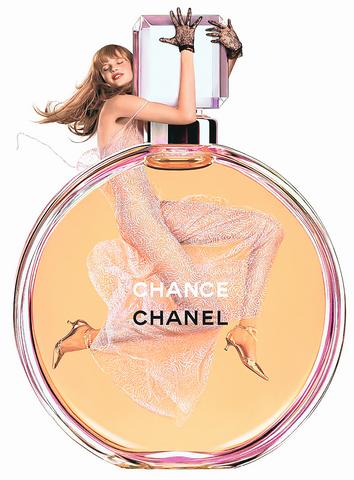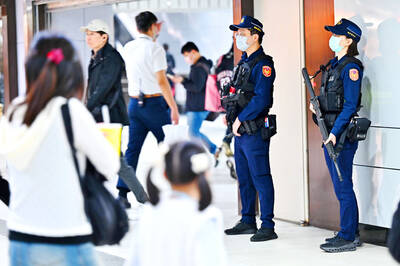For the past 81 years, the Chanel name has carried a special resonance for women 30 and older, who have made Chanel No. 5 the world's leading fragrance. But the younger market has proved elusive for Chanel, a state of affairs it intends to change with the introduction of its latest fragrance appealing to 20-somethings.
Chanel's name for the new fragrance -- Chance -- is fitting. To capture the fancy of this fickle young group of women between the ages of 18 and 29, Chanel is giving Chance the biggest marketing push in the company's history -- with an introductory budget estimated at more than US$12 million. Chanel is flinging itself into a market already crowded by competitors' earlier entrants, like Happy by Clinique and CK One from Calvin Klein.

PHOTO: NY TIMES
Chanel's aggressive plans are self-explanatory, according to industry observers. "Young consumers are the lifeblood of the beauty industry," said Irma Zandl, president of the Zandl Group in New York, a consulting company that specializes in the under-30 age category. She added that, "A brand not recruiting teens or young adults is just getting old."
Over the last six years, Chanel has gradually made inroads into the younger consumer market. In 1996, the company introduced Allure, marketed to women in their late 20s and 30s. Coco Mademoiselle soon followed, and its target market was women 25 and up.
"So, it's not something that, you know, we just woke up one day and said `Oh, uh-oh, No. 5 customers are aging, we better go find a younger consumer,'" said Laurie Palma, senior vice president for fragrance and Internet marketing at Chanel Inc. in New York.
But neither Allure nor Coco Mademoiselle have made great inroads into the 18 to 34 market, which represents a third of the US$2 billion women's fragrance market. According to a 2001 Women's Fragrance Track Consumer Study by NPD BeautyTrends in Port Washington, New York, which tracks the beauty industry, the leading brands owned and used most often by women 18-to-34 years old include: Happy by Clinique, which had overall sales of US$101 million in 2001; Romance by Ralph Lauren, at US$63 million; Tommy Girl by Tommy Hilfiger, at US$42 million; Victoria's Secret Divine (which is not tracked by NPD, but has annual sales estimated at US$40 million); Lancaster Cool Water Woman at US$30 million; Calvin Klein's Obsession at US$27 million; and CK One at US$20 million.
Arie L. Kopelman, president and chief operating officer at Chanel Inc, the US unit of the French couture house Chanel, is confident that Chance will be among the top tier of this group. He predicts that "in the short term," Chance will be "as big as Chanel No. 5."
Domestic sales for No. 5 were US$50 million in 2001, putting it in sixth place among all fragrances, according to NPD.
Chanel has given Chance a light, fresh, floral scent, which Palma said is meant to convey a youthful, sexy and romantic attitude.
To differentiate it from all other square-shaped Chanel fragrances that are packaged in black and white or beige, the Chance bottle is circular and packaged in pink. The scent, with an entry price point of US$38.50, will be available in domestic department stores later this month and in other countries next spring.
The ads, created by an in-house team and photographed by Jean-Paul Goude, also try to differentiate Chance from some of the other successful fragrances geared to 20-somethings. The print ad features a 16-year-old Russian model, Anne Vyalitsyna, dressed in a gown, clinging to the enormous bottle, embracing "her chance." The tag line reads, "The unexpected new Chanel fragrance."
"I don't think Chanel in bluejeans would be interesting," Palma said. "That's Tommy or Ralph, which they have already."
The television commercial, shot in Venice, Italy, is set to the tune "Taking a Chance on Love" and shows a young couple doing just that.
Chance will also have a major Internet program within the Chanel Web site, scented impressions in magazines and extensive sampling efforts, including rollerball mini-bottles in targeted areas like college campuses.
"We have tried to make Chance modern and young and do all the things that we needed to do for this generation, but still keep it grounded, rooted in what Chanel is all about." He added, "And you can have your cake and eat it in this situation. They are not mutually exclusive."
The marketing effort could turn off some of Chanel's core audience, warned Clive Chajet, a corporate identity and brand consultant. If Chance is for the young, then "all other Chanel fragrances are for older women only. And if you're not using their younger fragrance, then you're old."
But, in the end, Zandl said, "It's all about the juice. The advertising can bring them to the fragrance bar where they're going to test it, but then it's the juice itself is what makes the sale."

TRAGEDY STRIKES TAIPEI: The suspect died after falling off a building after he threw smoke grenades into Taipei Main Station and went on a killing spree in Zhongshan A 27-year-old suspect allegedly threw smoke grenades in Taipei Main Station and then proceeded to Zhongshan MRT Station in a random killing spree that resulted in the death of the suspect and two other civilians, and seven injured, including one in critical condition, as of press time last night. The suspect, identified as a man surnamed Chang Wen (張文), allegedly began the attack at Taipei Main Station, the Taipei Fire Department said, adding that it received a report at 5:24pm that smoke grenades had been thrown in the station. One man in his 50s was rushed to hospital after a cardiac arrest

A car bomb killed a senior Russian general in southern Moscow yesterday morning, the latest high-profile army figure to be blown up in a blast that came just hours after Russian and Ukrainian delegates held separate talks in Miami on a plan to end the war. Kyiv has not commented on the incident, but Russian investigators said they were probing whether the blast was “linked” to “Ukrainian special forces.” The attack was similar to other assassinations of generals and pro-war figures that have either been claimed, or are widely believed to have been orchestrated, by Ukraine. Russian Lieutenant General Fanil Sarvarov, 56, head

SAFETY FIRST: Double the number of police were deployed at the Taipei Marathon, while other cities released plans to bolster public event safety Authorities across Taiwan have stepped up security measures ahead of Christmas and New Year events, following a knife and smoke bomb attack in Taipei on Friday that left four people dead and 11 injured. In a bid to prevent potential copycat incidents, police deployments have been expanded for large gatherings, transport hubs, and other crowded public spaces, according to official statements from police and city authorities. Taipei Mayor Chiang Wan-an (蔣萬安) said the city has “comprehensively raised security readiness” in crowded areas, increased police deployments with armed officers, and intensified patrols during weekends and nighttime hours. For large-scale events, security checkpoints and explosives

PUBLIC SAFETY: The premier said that security would be tightened in transport hubs, while President Lai commended the public for their bravery The government is to deploy more police, including rapid response units, in crowded public areas to ensure a swift response to any threats, President William Lai (賴清德) said yesterday after a knife attack killed three people and injured 11 in Taipei the previous day. Lai made the remarks following a briefing by the National Police Agency on the progress of the investigation, saying that the attack underscored the importance of cooperation in public security between the central and local governments. The attack unfolded in the early evening on Friday around Taipei Main Station’s M7 exit and later near the Taipei MRT’s Zhongshan